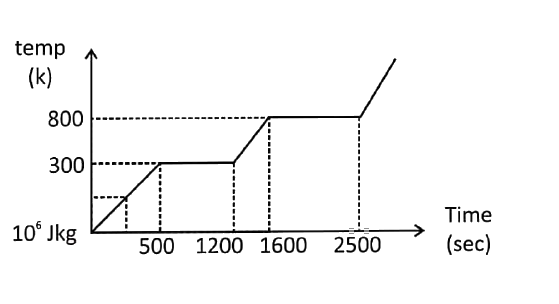Latent heat of fusion and latent heat of vaporization
Step-by-Step Solution
1. Definition of Latent Heat of Fusion:
- The latent heat of fusion is defined as the amount of heat energy required to change a substance from a solid state to a liquid state without any change in temperature. This process occurs at the melting point of the substance.
2. Characteristics of Latent Heat of Fusion:
- The temperature remains constant during the phase change.
- It is specific to the substance and varies from one material to another.
- Example: When ice melts to become water, it absorbs heat without increasing in temperature.
3. Definition of Latent Heat of Vaporization:
- The latent heat of vaporization is defined as the amount of heat energy required to change a substance from a liquid state to a vapor (gas) state without any change in temperature. This process occurs at the boiling point of the substance.
4. Characteristics of Latent Heat of Vaporization:
- Similar to fusion, the temperature remains constant during the phase change.
- It is also specific to the substance and varies from one material to another.
- Example: When water boils to become steam, it absorbs heat without increasing in temperature.
5. Comparison of Latent Heat of Fusion and Vaporization:
- Phase Change:
- Latent heat of fusion changes solid to liquid.
- Latent heat of vaporization changes liquid to gas.
- Temperature:
- Both processes occur without a change in temperature.
- Heat Requirement:
- Different amounts of heat are required for each process, with vaporization generally requiring more heat than fusion for the same mass of substance.
Summary
- Latent Heat of Fusion: Heat required to convert solid to liquid at constant temperature.
- Latent Heat of Vaporization: Heat required to convert liquid to gas at constant temperature.
---
- The latent heat of fusion is defined as the amount of heat energy required to change a substance from a solid state to a liquid state without any change in temperature. This process occurs at the melting point of the substance.
- The temperature remains constant during the phase change.
- It is specific to the substance and varies from one material to another.
- Example: When ice melts to become water, it absorbs heat without increasing in temperature.
- The latent heat of vaporization is defined as the amount of heat energy required to change a substance from a liquid state to a vapor (gas) state without any change in temperature. This process occurs at the boiling point of the substance.
- Similar to fusion, the temperature remains constant during the phase change.
- It is also specific to the substance and varies from one material to another.
- Example: When water boils to become steam, it absorbs heat without increasing in temperature.
- Phase Change:
- Latent heat of fusion changes solid to liquid.
- Latent heat of vaporization changes liquid to gas.
- Temperature:
- Both processes occur without a change in temperature.
- Heat Requirement:
- Different amounts of heat are required for each process, with vaporization generally requiring more heat than fusion for the same mass of substance.
- Latent Heat of Fusion: Heat required to convert solid to liquid at constant temperature.
- Latent Heat of Vaporization: Heat required to convert liquid to gas at constant temperature.
Similar Questions
Define latent heat of fusion and latent heat of vaporisation.
View SolutionA given mass m of a solid is supplied with heat continuously at a constant rate and the graph shown in the adjacent figure is plotted. If Lf and Lv are latent heats of fusion and latent heats of vapourisation and Sl and Ss are specific heats of liquid and solid respectively. It can be concluded that

View SolutionFill in the blank spaces by choosing the correct words from the list given below:
latent heat of fusion, melting point, steam, constant, latent heat of vaporisation.
__________has the highest speficif latent heat of vaporisation.
View SolutionFill in the blank spaces by choosing the correct words from the list given below:
latent heat of fusion, melting point, steam, constant, latent heat of vaporisation.
During the change of state of a substance its temperature remains___________.
View SolutionFill in the blank spaces by choosing the correct words from the list given below:
latent heat of fusion, melting point, steam, constant, latent heat of vaporisation.
The temperature at which a solid starts changing to liquid state is called__________.
View SolutionIf boiling point of an aqueous solution is 100.1∘C. What is its freezing point? Given latent heat of fusion and vaporization of water are 80calg−1 and 540calg−1 respectively.
View SolutionFill in the blank spaces by choosing the correct words from the list given below:
latent heat of fusion, melting point, steam, constant, latent heat of vaporisation.
The amount of heat required to change 1 g of a substance at its melting point into liquid state without any rise in temperature is called specific_________.
View SolutionFill in the blank spaces by choosing the correct words from the list given below:
latent heat of fusion, melting point, steam, constant, latent heat of vaporisation.
The amount of heat required to change 1 g of a liquid into its gaseous state without and rise in temperature is called specific ___________.
View SolutionWhat is the amount of heat required (in calories) to convert 10 g of ice at −10∘C into steam at 100∘C? Given that latent heat of vaporization of water is 540 cal g−1, latent heat of fusion of ice is 80 cal g−1, the specific heat capacity of water and ice are 1 cal g−1.∘C−1 and 0.5 cal g−1.∘C−1 respectively.
View SolutionA heating curve has been plotted for a solid object as shown in the figure. If the mass of the object is 100g, then latent heat of vaporization for the material of the object is [Given, power supplied to the object is constant and equal to 1 kW]

View Solution
